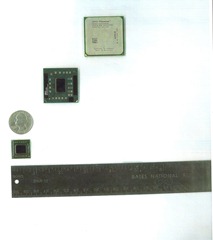This week at CES, AMD is launching their AMD Fusion family of Accelerated Processing Units (APUs). What’s an APU? An APU is the combination of the CPU and GPU into a single die. What AMD has done with their Fusion family of APU processors is to combine multi-core CPU (x86) technology with discrete-level graphics.
Update: The above image is a scan of a AMD CPU (top), a AMD GPU mobile laptop CPU (middle) and a AMD Fusion APU (bottom) compared to a U.S. Quarter.
The graphics side of the Fusion APU is powered with what AMD is calling the VISION Engine. The VISION Engine consists of DirectX 11 capable graphics capabilities, a UVD3 video acceleration block (like the one found in the new AMD Radeon HD 6800 Series GPUs) for native mpeg-4, mpeg-2, h264, DivX decoding, and parallel processing designed to help speed up application performance. A PC with an AMD Fusion APU can take full advantage of hardware-accelerated web browsing with Internet Explorer 9 and Windows 7.
AMD Fusion APUs also come with AMD’s AllDay Power feature for about 10 hours (or more) of battery life. Fusion APUs are also virtualization-capable as well.
The 2011 low-power AMD Fusion APU platform (codenamed “Brazos”), designed for everyday computing for PCs like netbooks and other small form factor PCs, will come in 2 flavors: the E-Series and C-Series. These APUs come with AMD’s new x86 CPU core codenamed “Bobcat”. Later in 2011, the A-Series will hit designed for mainstream laptops and desktop PCs (codenamed “Llano”) which will have up to 4 x86 cores.
At CES, AMD expects many of the major PC OEMs to announce PCs with AMD Fusion APUs. Ben Rudolph will be stopping by to visit AMD to check out Fusion first-hand later this week. Ben will be behind-the-scenes at CES all week this week.
For more information on the AMD Fusion family of APUs, click here. You can also check out their press release here and quotes from their partners here.

